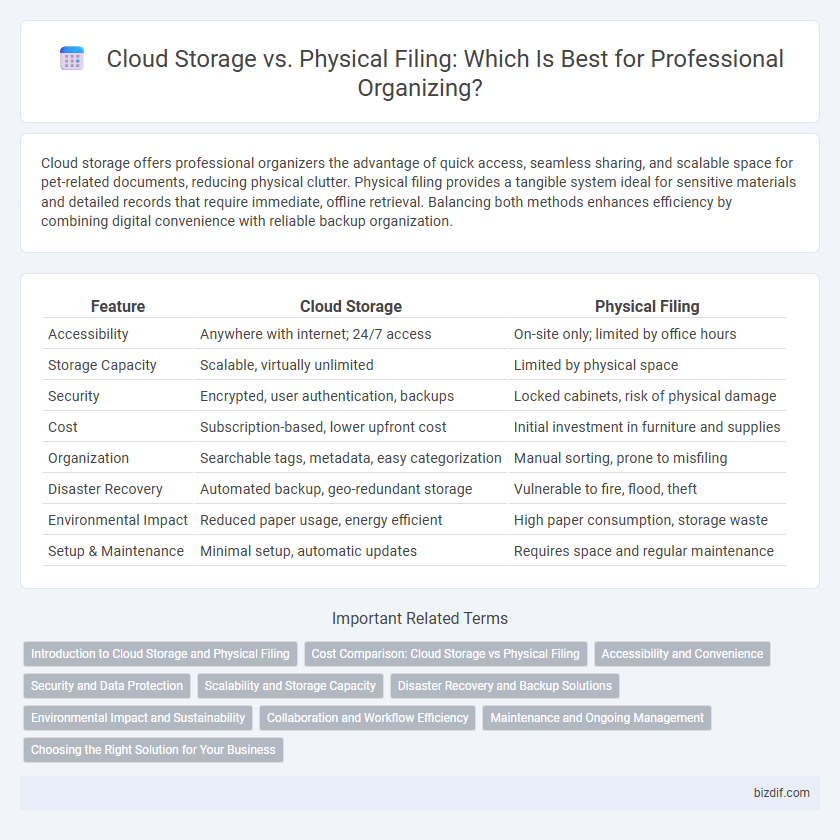Cloud storage offers professional organizers the advantage of quick access, seamless sharing, and scalable space for pet-related documents, reducing physical clutter. Physical filing provides a tangible system ideal for sensitive materials and detailed records that require immediate, offline retrieval. Balancing both methods enhances efficiency by combining digital convenience with reliable backup organization.
Table of Comparison
| Feature | Cloud Storage | Physical Filing |
|---|---|---|
| Accessibility | Anywhere with internet; 24/7 access | On-site only; limited by office hours |
| Storage Capacity | Scalable, virtually unlimited | Limited by physical space |
| Security | Encrypted, user authentication, backups | Locked cabinets, risk of physical damage |
| Cost | Subscription-based, lower upfront cost | Initial investment in furniture and supplies |
| Organization | Searchable tags, metadata, easy categorization | Manual sorting, prone to misfiling |
| Disaster Recovery | Automated backup, geo-redundant storage | Vulnerable to fire, flood, theft |
| Environmental Impact | Reduced paper usage, energy efficient | High paper consumption, storage waste |
| Setup & Maintenance | Minimal setup, automatic updates | Requires space and regular maintenance |
Introduction to Cloud Storage and Physical Filing
Cloud storage offers secure, scalable, and easily accessible digital file management, reducing physical clutter and enabling remote access from multiple devices. Physical filing relies on tangible storage systems like filing cabinets and folders, ensuring immediate offline access and straightforward organization without dependence on internet connectivity. Both methods provide essential solutions for document management, with cloud storage prioritizing convenience and backup, while physical filing emphasizes tactile organization and security control.
Cost Comparison: Cloud Storage vs Physical Filing
Cloud storage typically reduces upfront costs by eliminating the need for physical materials like filing cabinets, paper, and ink, while offering scalable subscription pricing based on storage capacity. Physical filing incurs ongoing expenses for office space, maintenance, and supplies, which can escalate with increasing documents. Over time, cloud solutions often prove more cost-effective by minimizing physical overhead and streamlining document access and security management.
Accessibility and Convenience
Cloud storage offers unparalleled accessibility by allowing users to retrieve documents anytime and anywhere with an internet connection, significantly enhancing convenience compared to physical filing systems. Digital files can be quickly searched, shared, and backed up, reducing the risk of loss and the time spent managing paper clutter. Physical filing requires more effort to organize, access, and secure, often limiting availability to a single location and increasing the potential for misplacement.
Security and Data Protection
Cloud storage offers robust security features such as encryption, multi-factor authentication, and regular backups, significantly reducing the risk of data loss or unauthorized access compared to physical filing. Physical filing systems are vulnerable to theft, damage from fire or water, and require secure, controlled access environments which can be costly and less reliable. For professional organizing, leveraging cloud storage ensures scalable, secure data protection with compliance options for GDPR, HIPAA, and other regulations.
Scalability and Storage Capacity
Cloud storage offers virtually unlimited scalability, allowing businesses to expand their digital archives without physical limitations, while physical filing systems require additional space and resources as inventory grows. Cloud platforms provide flexible storage capacities that adjust to fluctuating demands, optimizing cost-efficiency compared to the fixed capacity of filing cabinets and storage rooms. This dynamic scalability makes cloud storage ideal for managing large volumes of documents and data over time in professional organizing environments.
Disaster Recovery and Backup Solutions
Cloud storage provides automated backup solutions with real-time data synchronization, minimizing data loss during disasters like fires or floods. Physical filing systems require off-site duplicates and manual updates to ensure recovery, often leading to delays and increased risk of permanent loss. Incorporating cloud storage significantly enhances disaster recovery plans by enabling rapid access and restoration of critical documents.
Environmental Impact and Sustainability
Cloud storage reduces reliance on paper, significantly lowering deforestation and waste production compared to physical filing systems. Data centers powering cloud storage, while consuming energy, are increasingly optimized for renewable energy sources, enhancing sustainability. Physical filing requires ongoing material use and disposal, contributing to landfill volume and resource depletion, making cloud storage a more environmentally responsible option for professional organizing.
Collaboration and Workflow Efficiency
Cloud storage enhances collaboration by enabling real-time access and simultaneous editing of documents across multiple devices and locations, streamlining workflow efficiency. Physical filing often limits teamwork due to its dependency on a central location and slower retrieval times, causing delays in project completion. Integrating cloud storage solutions reduces bottlenecks and accelerates communication, optimizing professional organizing processes.
Maintenance and Ongoing Management
Cloud storage simplifies maintenance with automatic backups, real-time synchronization, and easy scalability, reducing the risk of data loss and ensuring seamless document retrieval. Physical filing requires regular manual sorting, labeling, and protection from environmental factors like moisture and light, increasing ongoing management efforts. Efficient organizational systems leverage cloud platforms such as Google Drive or Dropbox to streamline document updates and collaboration while minimizing physical space and upkeep.
Choosing the Right Solution for Your Business
Evaluating cloud storage versus physical filing depends on factors such as data accessibility, security needs, and volume of documents. Cloud storage offers scalable, remote access with advanced encryption, ideal for dynamic businesses seeking efficiency and disaster recovery. Physical filing suits businesses requiring tangible document management but may increase space costs and risk of physical damage.
cloud storage vs physical filing Infographic

 bizdif.com
bizdif.com